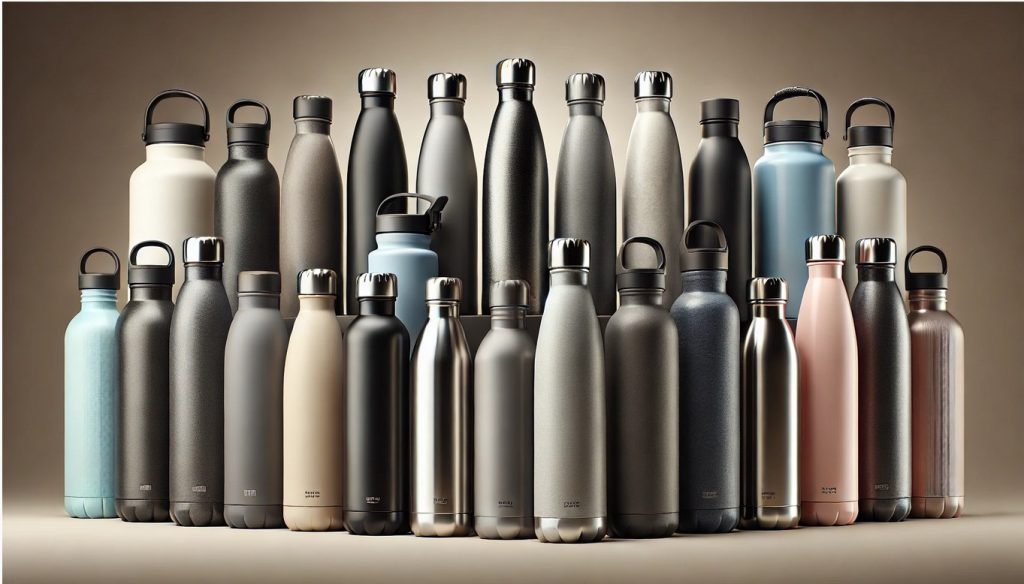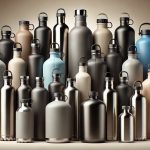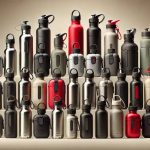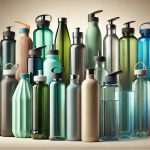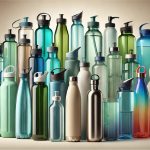Insulated water bottles have become a must-have item for people who prioritize convenience, hydration, and sustainability. Offering advanced features like temperature retention and enhanced durability, these bottles have quickly replaced traditional plastic bottles in daily routines. Whether for athletes, travelers, or outdoor enthusiasts, insulated water bottles provide the perfect solution for keeping beverages at the ideal temperature for hours.
What Are Insulated Water Bottles?
Insulated water bottles are specially designed containers made from materials that help maintain the temperature of liquids for an extended period. They use double-wall insulation technology, which creates a barrier between the interior liquid and the external environment. This prevents heat from transferring into the bottle for hot beverages or from escaping for cold ones. The result is that your drinks stay at the desired temperature for hours—whether you’re drinking something hot or cold.
Construction of Insulated Water Bottles
The key feature that distinguishes insulated water bottles from regular water bottles is their multi-layered construction. Here are the primary components of an insulated water bottle:
Outer Layer: Stainless Steel or Aluminum
Most insulated water bottles are made from stainless steel due to its excellent durability, resistance to rust, and ability to withstand extreme temperatures. Some insulated bottles are also made from aluminum, which is lightweight but less durable than stainless steel. The outer layer serves as a protective shield for the bottle’s contents and helps provide a sturdy structure.
Inner Layer: Stainless Steel
The inner lining of an insulated bottle is typically made from stainless steel. This layer is essential for maintaining the temperature of your beverage and ensuring that it doesn’t react with the liquid inside. Stainless steel is non-reactive, meaning it doesn’t impart any taste or odor to your drinks.
Insulating Barrier: Vacuum-Sealed Technology
The vacuum-sealed space between the inner and outer layers is what gives insulated bottles their ability to maintain the temperature of liquids. This vacuum barrier prevents heat transfer, ensuring that your cold beverages remain chilled, and hot drinks stay warm for longer.
Types of Insulated Water Bottles
There are various types of insulated water bottles on the market, each designed for different purposes. The most common types are:
Standard Insulated Bottles
These are the most common type of insulated water bottles and are designed for everyday hydration. They typically feature a double-wall vacuum seal, which ensures that the temperature of your beverages remains constant for hours. Standard insulated bottles come in a variety of sizes and can be used for both hot and cold beverages.
Sports Bottles
Sports bottles are designed specifically for active individuals and athletes. These bottles often feature a one-handed drinking lid, making it easy to hydrate during exercise or physical activity. Many sports bottles are designed to fit into standard bike bottle holders or gym cup holders. Sports bottles are often made with durable materials and ergonomic designs to make drinking while on the move more convenient.
Travel Bottles
Travel bottles are built to keep drinks hot or cold for longer durations, making them an ideal companion for long trips or commutes. These bottles often come with features like leak-proof lids, a larger capacity, and a more insulated design to ensure that your beverages remain at the desired temperature throughout the day.
Tumblers and Mugs
Tumblers and mugs with insulation are also popular in the insulated bottle market. These bottles are designed to provide comfort and convenience for coffee drinkers or individuals who prefer to sip their beverages throughout the day. Many insulated tumblers come with additional features like built-in straws or cup holders for easy portability.
Benefits of Using Insulated Water Bottles
Insulated water bottles provide numerous advantages, making them a worthwhile investment for individuals seeking to improve their hydration habits and reduce their environmental footprint.
Temperature Retention
The primary benefit of insulated water bottles is their ability to maintain the temperature of beverages for extended periods. Whether you’re carrying a hot coffee for a morning commute or a cold beverage for a long hike, an insulated bottle ensures that your drink stays at the perfect temperature for hours.
Hot Beverages
Insulated bottles designed for hot drinks typically maintain a temperature of around 140°F to 180°F (60°C to 82°C) for up to 12 hours. This makes them ideal for coffee, tea, or soups during cold weather activities or for those who need a hot beverage while traveling.
Cold Beverages
Cold beverages, on the other hand, can stay chilled for up to 24 hours in an insulated bottle. If you’re hiking, working out, or spending time outdoors in warm conditions, having cold water, juice, or any other chilled drink at your disposal can be a refreshing experience.
Durability and Longevity
Insulated water bottles are designed to be durable and long-lasting. Made from high-quality stainless steel, these bottles are resistant to dents, scratches, and corrosion. Unlike plastic bottles that degrade over time, insulated water bottles can withstand rough use and still maintain their functionality. Their durability makes them ideal for outdoor adventures, long commutes, or sports activities.
Environmentally Friendly
Using an insulated water bottle significantly reduces plastic waste. Each year, millions of single-use plastic bottles end up in landfills, contributing to the growing environmental crisis. By switching to an insulated water bottle, you reduce the need for disposable plastic bottles and contribute to a more sustainable lifestyle. Since insulated water bottles are reusable and long-lasting, they also help cut down on the carbon footprint associated with producing new plastic bottles.
Healthier Hydration
Many insulated bottles are free from harmful chemicals such as BPA, which is commonly found in some plastic bottles. BPA is a controversial compound linked to several health risks, including hormonal imbalances and other negative effects on human health. Insulated bottles made from stainless steel are typically BPA-free, making them a safer and healthier option for hydration. Additionally, stainless steel does not retain odors or flavors, ensuring that each drink tastes fresh and clean.
Versatility and Convenience
Insulated water bottles are incredibly versatile. They can be used for a variety of beverages, including water, tea, coffee, sports drinks, smoothies, and even soup. Many insulated bottles come with user-friendly features, such as easy-to-carry handles, wide mouths for adding ice or fruit, and leak-proof lids for spill-free travel. Whether you’re heading to the gym, going on a hike, or simply commuting to work, an insulated bottle can be a practical companion for your daily activities.
Key Features to Look for in Insulated Water Bottles
When selecting an insulated water bottle, there are several key features you should consider to ensure that the bottle meets your needs. From temperature retention to portability, these factors can make a significant difference in your overall experience.
Size and Capacity
Insulated water bottles come in a range of sizes, from small 12 oz bottles for light hydration to larger 40 oz or even 64 oz bottles for extensive outdoor activities. When selecting a bottle, consider how much liquid you typically consume during the day, as well as your preferred bottle’s portability.
- Small Bottles (12 oz to 18 oz): Ideal for short trips, commuting, or those who prefer to carry a compact bottle.
- Medium Bottles (20 oz to 32 oz): Suitable for daily use and hydration throughout the day.
- Large Bottles (40 oz and above): Perfect for outdoor adventures, extended travel, or activities that require a larger supply of water or beverages.
Insulation Quality
The insulation quality of a bottle plays a major role in how effectively it can maintain the temperature of your drinks. Double-wall vacuum insulation is the most common technology used in insulated bottles, and it is highly effective at preventing heat transfer. Some high-end bottles use advanced insulation techniques, such as copper or foam, to improve temperature retention even further. When selecting a bottle, consider how long you need your beverages to stay hot or cold and choose a bottle with insulation that matches your needs.
Lid Design
The lid design of an insulated bottle is an important factor to consider. There are several types of lids, each with unique features suited for different purposes.
Screw-on Lids
Screw-on lids provide a secure seal and are commonly found in most insulated bottles. They prevent spills and leaks, making them a popular choice for daily use. Many screw-on lids come with additional features such as a built-in carrying handle or a spout for easy drinking.
Flip-top Lids
Flip-top lids offer easy access to your beverage and are designed for one-handed operation. These lids are commonly used in sports bottles and are ideal for athletes who need to drink while on the move.
Wide-mouth Lids
Wide-mouth lids allow for easy filling, cleaning, and adding ice cubes. They are particularly useful for people who want to customize their drinks with fruit, herbs, or other ingredients. Wide-mouth lids are also a popular option for those who enjoy using their insulated bottles for soups or smoothies.
Portability
Portability is another important factor when choosing an insulated bottle. If you’re constantly on the go, you’ll want a bottle that is easy to carry. Many insulated bottles come with handles, straps, or carabiner loops for convenience. A bottle with a handle makes it easy to carry, while a bottle with a strap can be hung from a bag or backpack. Some bottles are even designed to fit into cup holders, making them ideal for car commutes.
Durability and Material Quality
The materials used in the construction of the bottle are critical to its durability and performance. Stainless steel is the most popular choice for insulated bottles due to its resistance to corrosion, dents, and rust. The quality of the stainless steel is also important—higher-grade steel (such as 18/8 stainless steel) tends to be more resistant to wear and tear and provides better insulation. Avoid insulated bottles made from cheap materials, as they may not be as durable or effective in temperature retention.
Ease of Cleaning
When selecting an insulated bottle, consider how easy it is to clean. Some bottles have wide mouths, making them easier to clean by hand or in the dishwasher. Others may require disassembly or specialized cleaning tools, such as brushes for narrow straws. If you use your bottle for multiple types of beverages, look for one that can be easily cleaned to prevent any residual tastes or odors from affecting future drinks.
How to Care for Your Insulated Water Bottle
Proper care and maintenance will help extend the life of your insulated water bottle and keep it performing at its best. Here are some tips to ensure your bottle remains in top condition:
Cleaning Your Bottle
Most insulated bottles are dishwasher safe, but it’s important to check the manufacturer’s instructions before placing your bottle in the dishwasher. If you prefer handwashing, use warm soapy water and a sponge to clean both the interior and exterior of the bottle. For bottles with narrow mouths or complex lids, you may need a bottle brush to reach the bottom.
Preventing Odors and Stains
If your bottle develops odors or stains, there are several methods for eliminating them:
- Baking Soda and Vinegar: Add a tablespoon of baking soda and a small amount of vinegar to the bottle, fill it with warm water, and let it sit for several hours before rinsing thoroughly.
- Lemon and Baking Soda: For persistent odors, use lemon juice and baking soda to scrub the interior of the bottle.
- Dish Soap and Rice: Add some dish soap and uncooked rice to the bottle, then shake it gently to remove any buildup.
Drying Your Bottle
After cleaning your bottle, allow it to air dry completely. Leave the cap off to ensure that moisture doesn’t get trapped inside, which could lead to mold or mildew growth.
Storing Your Bottle
Store your insulated water bottle in a dry place when not in use. Keep the cap off to allow air circulation, preventing any moisture buildup inside. Avoid storing the bottle in a hot or humid environment, as excessive heat can degrade the insulation over time.

